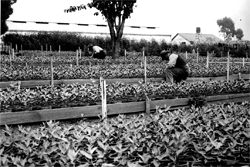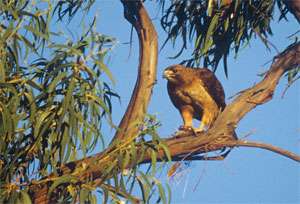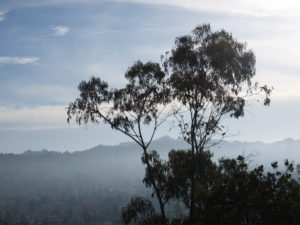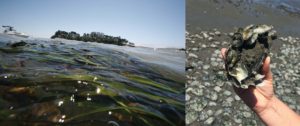Long, unruly strips of bark hang from the trees’ trunks, like so many torn posters on a wall. Instead of a floor covered with clothes and old magazines, the ground is littered with leaves, seed pods, and fallen branches. These last remind you that blue gums have a disconcerting reputation for occasionally dropping large limbs without warning.
Messy or not, the eucalypt is a major feature of the Berkeley-Oakland hills, and many other parts of the Bay Area. People have a love-hate relationship with the trees—eucalypts are loved for their grandeur, cool shade, and refreshing aroma, but despised as giant, fire-prone invaders that have taken over precious land from native plants. Most folks realize that eucalypts are Australian imports, but few people know how they actually got here.
Frank Havens (1848-1918) is one of those seminal figures in local history that you’ve probably never heard of. For better and worse, he embodied the “Age of Progress” of the early 1900s, when people thought that everything, including nature, could be improved by one grand scheme or another. Havens thought big. He was a prime mover behind Oakland’s early public transit and utility systems. He was one of the original developers of the Claremont Hotel, reportedly winning the property in a game of checkers. Together with famed miner/entrepreneur Francis “Borax” Smith (of Twenty Mule Team fame), he planned to buy every piece of available property between northern Alameda County and Gilroy.
And, more than anyone else before or since, he changed the landscape. Almost all of the eucalyptus in the East Bay Regional Parks—mostly in Tilden, Wildcat, Kennedy Grove, Anthony Chabot, Lake Chabot, Redwood, and Sibley Regional Parks—can be traced back to Frank Havens. In less than half a decade, his workers turned thousands of acres of hillside grassland into a chain of eucalyptus plantations.
This land had once been blanketed with native grasses, and punctuated by annual displays of colorful wildflowers. But most of it had been considerably altered before Havens arrived on the scene. Native Americans had regularly burned the grasses in order to help propagate seeds, and to suppress the natural succession of grasslands to scrub to woodlands. Europeans brought in exotics like ryegrass, wild oats, and foxtail, hypercompetitors that quickly invaded the native grasslands.
After the Gold Rush, large tracts of grassland were plowed under to allow for dry-field hay farming. Others were used for intensive livestock grazing, which stripped the soil bare. When the 1906 earthquake drove people to the East Bay from San Francisco, even more houses and roads were built, further decreasing the amount of open space. “Tree planting was the last assault,” says Stephen Edwards, director of the Regional Parks Botanic Garden.
Havens founded the People’s Water Company in 1906, controlling almost all of the undeveloped watershed property from Richmond to San Leandro. In 1910, he started planting the entire 20-mile swath of land with eucalyptus. Within four years, his Mahogany Eucalyptus and Land Company had set out between one and three million eucalyptus and Monterey pine seedlings on 3,000 acres in the East Bay.
- In the century since eucalyptus became common here, somenative species have profited, while others have suffered. Red-tailedhawks (above) have adapted, often nesting in the trees. Photo by Mark Brown.
Eucalyptus trees were supposed to make him a quick fortune. “This tree at this particular moment is in many instances the most valuable one on the face of the globe,” reads his company’s prospectus, written by Havens’s son, Seyd. Money, it seemed, did grow on trees. “The company now sees plainly that it possesses a source of emolument higher than that of the average gold mine.” First brought to Europe as curiosities in the 1770s, the trees supposedly could be used to dry up swamps and cure cholera, bronchial disorders, and yellow fever. Havens further claimed that the lumber was perfect for a wide range of uses, “from telegraph poles to railway sleepers or from violins to ecclesiastical furniture and insulator pins.” Shingles made from eucalyptus were reputed to be fire resistant, while other accounts touted it as excellent firewood.
There are at least 600 species of eucalyptus, named for their flowers’ rigid petals and sepals (eu means “well,” calyptos, “covered”). All but two of them are native to Australia, and they range in size from small shrubs to the giant mountain ash (E. regnans), which can grow to over 300 feet tall.
Eucalyptus arrived in California in 1856, and demand for the trees increased as cities grew. California had precious few hardwood trees, and it would take decades, if not centuries, to grow eastern species like oak and maple large enough to use as lumber. On the other hand, eucalypts grew at an astonishing rate, likely helped by the absence of native pests. One grower reported having 40-foot trees just six years after planting them.
Quickly covering bare hillsides with sizable trees held tremendous appeal for residents who thought land barren without trees. One local newsletter, believed to have been written by architect Bernard Maybeck in about 1906, summed up the aesthetic of the day: “Grass on a hillside looks bare; the same strength and water put on trees and bushes will be more effective.”
Eucalyptus also coppice well – when one is cut, or otherwise damaged (e.g., by frost or fire), many new trunks sprout from the base. That meant growers would never have to plant more trees, because each harvested eucalypt would replace itself several times over. “Magic is the only word applicable,” Seyd Havens enthused.
Frank Havens jumped into the eucalyptus craze on a grand scale. In addition to planting the trees, he built nine plant nurseries, a sawmill, and an arboretum. Havens employed up to 200 workers during peak planting time, paying them a nickel for every seedling they sowed.
But even as Havens’s trees were putting down roots, there were signs the eucalyptus boom would be short-lived. A 1908 UC report said eucalyptus wood had an unfortunate tendency to chip when planed and crack when dried. Havens brought in an East Coast forester who milled and dried the wood to see if it would make good lumber. The news was bad – only the largest blue gums were suitable for commercial purposes, and even these needed special handling. In 1914 Havens pulled the plug on his grand eucalyptus scheme.
The question of why Havens got so involved in eucalyptus planting is still a mystery. Perhaps the salesman had himself been sucked in by other schemers and dreamers promoting the “get-rich-quick” trees. Even today, no one is sure why California eucalyptus failed so badly as lumber. Some speculate it’s because of the state’s Mediterranean climate (the blue gums’ home territory, Tasmania, is more of a rain forest); others say the trees, like those logged successfully in Australia, should be 150 years old before they are harvested.
The sawmill and nurseries have disappeared, but the eucalyptus forest is still with us. Although Havens planted dozens of species, only two were cultivated in significant numbers: the river red gum (E. camaldulensis) and the much more abundant Tasmanian blue gum (E. globulus). The blue gum is usually larger, and the leaves are more curved than those of the red gum. During the winter and early spring, it has large, yellowish flowers. Later in the season, the inch-long, blue-green seed pods (one end inscribed with an X, Y, or star) drop to the ground in profuse numbers. The red gum’s summer-blooming flowers are less impressive, and its seed pods are about the size and shape of a large pea.
After Havens’s operation shut down, eucalyptus’s reputation took a tumble, too. Today, many people regard eucalyptus as at best a nuisance and at worst a menace.
Topping the list of concerns is fire. Eucalypts (along with equally flammable Monterey pines) have been implicated in several disastrous conflagrations in the East Bay hills, including the deadly 1991 firestorm that destroyed almost 3,000 homes.
Eucalyptus can be a firefighter’s nightmare, says East Bay Regional Park District Fire Chief Dennis Rein. Its leaves are loaded with highly flammable oils. Dead leaves and bark accumulate in a thick layer underneath the trees, and when this understory catches fire, it releases twice as much energy as a comparable grasslands blaze. Flames can reach the upper branches and form a “crown fire” that jumps rapidly from tree to tree. A hard frost can make matters worse – the trees’ leaves and small branches die, but the trunks and roots survive and sprout brushy, more flammable new growth.
Jerry Kent, the park district’s former assistant general manager, says that Havens inadvertently caused many of the fire problems. Havens’s unusually flammable plantations had from 400 to 900 trees per acre, far more than the 30 to 50 trees per acre found in fire-safe groves. This can lead to a huge accumulation of leaf litter, and Havens planted the trees along ridgelines where they are exposed to the hot dry Diablo winds in the fall.

- Between 1910 and 1914, entrepreneur frank Haven’s workersplanted thousands of eucalyptus all over the East Bay hills. Here,workers tend seedlings in one of his nine nurseries. Photo courtesyMarian Koshland Bioscience & Natural Resource Library, Universityof California.
Even if the trees weren’t fire-prone, many environmentalists would still see large stands of eucalyptus as monocultures that replaced diverse plant communities. Writing in the early 1970s, James Roof, then-director of the park district’s botanic garden, called eucalyptus “horrible water suckers” that concentrate moisture underneath their canopy, leading to the growth of “thickets” of blackberries, poison oak, ivy, and wild cucumber: “The end result is the rendering of once open, sunny, wildflower-bearing land into foreboding and pestilential jungles, of no earthly use to man, bird, or beast.”
A eucalyptus grove is far from lifeless, however. Red-tailed hawks and great horned owls often nest in eucalyptus, especially if they are the only large trees available. Small birds feed on the nectar, and reptiles and amphibians live in the understory. A recent study by biologist David Suddjian counted more than 90 bird species that make regular use of Monterey County eucalyptus habitats, including at least 59 species that nest in them. Eucalyptus trees on the shores of San Leandro’s Lake Chabot host a large heron rookery. In Santa Cruz County, Suddjian found that great egrets, great blue herons, and double-crested cormorants nest exclusively in eucalyptus.
Birds fare best in less densely planted eucalyptus stands that include large, mature trees with spreading, complex branch structures that can support nests. Some birds can build nests in the loose bark on eucalyptus trunks, and woodpeckers sometimes excavate nest holes where wood has been softened by rot, but they and other cavity nesters otherwise have a difficult time excavating holes in the trees’ hard wood.
A 1975 study by UC Berkeley professor Robert Stebbins found that in terms of vertebrate life, East Bay eucalyptus groves are less diverse than chaparral or oak woodland habitats, but more so than nearby stands of Monterey pine or redwoods. He said that small animals use the thick litter underneath the trees for cover, and that the trees’ nectar, pollen, and seeds provide food. In fact, the nectar is a valuable winter food for hummingbirds and monarchs.
But that same nectar can also be a curse for some birds. Rich Stallcup, of PRBO Conservation Science in Marin County, has noticed that the faces of some birds, especially yellow-rumped warblers, Bullock’s orioles, Anna’s hummingbirds, and ruby crowned kinglets, can get coated with a tarry pitch when they push their bills deep into the flowers in search of nectar or insects. Their nostrils can get clogged and they suffocate.
Monarch butterflies are perhaps the most celebrated eucalyptus denizens, clustering in the trees by the thousands each winter. The most famous monarch assembly is in Pacific Grove, but Fremont’s Ardenwood Historic Farm and Richmond’s Point Pinole Regional Park also host annual monarch gatherings in their eucalypts. Protected from the wind, the insects cling to the trees’ branches and feed on their nectar.
Ardenwood and its monarchs were hard hit by an Australian longhorn wood-boring beetle that arrived in the early 1990s, killing some 2,500 blue gums. The park district worked with UC Riverside to introduce Australian parasitic wasps to Ardenwood, Point Pinole, and Anthony Chabot to control the borers. Though the monarch habitat had already been damaged, the wasp introduction has proved successful and self-sustaining. A new insect pest, the lerp psyllid, appeared a few years later and threatened to kill newly planted red gum saplings. The district, working with UC Berkeley’s Center for Biological Control, has introduced another parasitic wasp to control the lerp psyllid, but it’s not yet clear if those wasp populations will be self-sustaining.
There’s a fine stand of eucalyptus near the Tilden Nature Area Visitors’ Center, where veteran naturalist Alan Kaplan frequently leads hikes. He takes me along the Jewel Lake Trail, pointing out details that a hiker could easily miss. He urges me to poke my finger into a blue gum blossom. The nectar is thick and sweet, richer than honeysuckle—those butterflies have good taste.
Eucalyptus is often thought of as “invasive.” That’s something of a misnomer—they can spread by reseeding, but a small stand of eucalyptus won’t expand the way a single Algerian ivy plant takes over an entire hillside. They do reproduce aggressively by coppicing, however. “I call it the hydra effect,’ Kaplan says. This characteristic may have delighted timber growers, but it gives modern-day foresters a giant headache. The trees can’t simply be cut down. If the stumps aren’t treated with herbicides, or repeatedly trimmed by hand, the result can be a bushy thicket.
While some people would probably like to see every eucalypt in the state pulled up by its roots tomorrow, the consensus seems to be to take a more gradual approach, slowly thinning the eucalyptus to allow natives to come back. With 1,400 acres of eucalyptus on its lands, the park district maintains a fuel break along a 25-mile strip of ridge between Castro Valley and Richmond, where it tries to remove as many eucalyptus as possible. In other areas, including Claremont Canyon, the district manages the understory, removing leaf litter and trimming low-hanging branches. The East Bay Municipal Utility District is gradually thinning its 215 acres of eucalyptus. As this happens, natives like oak and bay will take advantage of the additional sunlight and become dominant.
“There are a million bays and oaks growing underneath the eucalyptus,” says Kaplan. Their seeds were probably “planted’ by Steller’s jays, and if given a chance, a healthy native forest could someday replace the Australian imports.
He stops to marvel at one eucalypt that towers at least 60 feet over the trail. Kaplan has watched it grow a foot a year for the three decades he’s been at Tilden. He points out that the trees have been part of the landscape for nearly a century. “I like to think of them as being naturalized – another naturalized citizen.”

.jpg)




